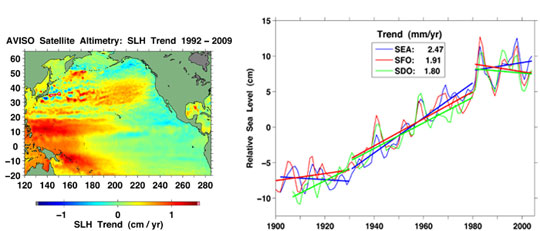After several decades of minimal sea-level rise along the U.S. west coast, there might be a change in the wind – literally.
In other words, a change in wind patterns that might now be occurring could be associated with accelerated coastal sea-level rise in the eastern North Pacific, beginning this decade, according to a study now in press (subscription required) that will appear in the Journal of Geophysical Research-Oceans, published by the American Geophysical Union.
The study – led by Peter Bromirski of Scripps Institution of Oceanography, UC San Diego – suggests that conditions of the past several decades, which were dominated by cold surface waters along the U.S. west coast, could soon flip into an opposite state.
Bromirski said:
There are indications that this is what might be happening right now.
Global sea level rose during the 20th century at a rate of about two millimeters (.08 inches) per year. That rate increased by 50% during the 1990s to a global rate of three millimeters (.12 inches) per year, an uptick frequently linked to global warming. Meanwhile, sea level along the U.S. west coast did not experience the same amount of rise as that seen globally.
We are talking here about a rise of only millimeters, and yet even a slight rise in sea level does have consequences along coastlines heavily populated by humans. Some coastal development could be affected by even a slight sea level rise, and there could be an increase in beach erosion and wetlands inundation. A rise in sea level would be especially noticeable during times of high tides, storm surges or extreme wave conditions, according to these researchers.
The projected change in sea level along the U.S. west coast is linked to what these scientists are calling a regime change in a wind-and-ocean cycle called the Pacific Decadal Oscillation (PDO). The current phase of the cycle – linked to fairly steady sea level rise along the U.S. west coast – began in the mid- to late-1970s. They describe the current current phase as a warm phase; however, it is characterized by the upward movement, or upwelling, of cold water toward the surface along the U.S. west coast. There have been a few El Niño-induced surges in sea level during that time, these scientists note, but, mostly, the coastal sea level trend has been steady.
When the PDO cycle shifts to its cold phase, coastal ocean waters will experience what these scientists call a downwelling regime; that is, the amount of colder, denser water currently brought to the surface will be reduced. The water at the ocean surface will, thus, be warmer, and this warmer surface water is expected to raise sea level.


Bromirski and his team of oceanographers studied the wind stress patterns that characterize the different phases of the PDO. Wind stresses can act to change the characteristics of the coastal upwelling and downwelling regime — that is, they can suppress or raise sea level.
In their paper, the authors wrote that the characteristics of wind stress variability over the eastern North Pacific …
… recently reached levels not observed since before the mid-1970s regime shift. This change in wind stress patterns may be foreshadowing a PDO regime shift, causing an associated persistent change … that will result in a concomitant resumption of sea level rise along the U.S. West Coast to global or even higher rates.
Several state and federal agencies, led by the California Department of Boating and Waterways, funded the study. Support also came from NOAA, the National Science Foundation, and the California Energy Commission.
Bottom line: Peter Bromirski and a team of oceanographers from Scripps Institution of Oceanography of the University of California, San Diego, report that wind pattern changes may be associated with a resumption of sea level rise along the U.S. west coast. Until now, sea level rise along the U.S. west coast has not been as great as elsewhere around the globe. This study is now in press in the Journal of Geophysical Research-Oceans, published by the American Geophysical Union.
Pool of Arctic meltwater could change global ocean circulation patterns, and more











